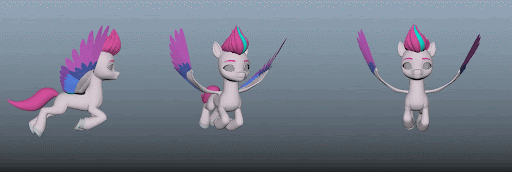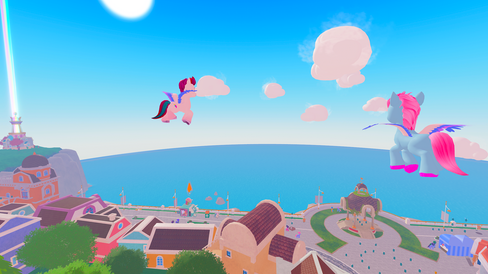My Little Pony Fandom Enters the Metaverse: Q&A with Media.Monks Nick Cicchetti
- Jordan Kelley
- Jan 31, 2023
- 7 min read

Want weekly exclusive brand storytelling content like this direct to your inbox? Subscribe to the Brand Storytelling Newsletter.
Media.Monks, the digital-first marketing and advertising services company, connects content, data and digital media and technology services to produce websites, games, films, social media content, digital advertising campaigns, data and measurement solutions, and more for their clients. In a recent partnership with Hasbro, Roblox, and TripAdvisor, Media.Monks sought to reach millennial parents and their children with a My Little Pony metaverse experience. Maretime Bay, a fully realized My Little Pony world within Roblox, allows fans of all levels and ages to engage with the world of My Little Pony and take the story in their own hands, offering mini-games, customizable features, and more.
Brand Storytelling caught up with Media.Monks Senior Producer Nick Cicchetti to learn more about the unique multi-brand partnership and where storytelling plays a factor in transmedia storytelling:

Where do you see the intersection between your expertise and storytelling?
It all comes down to understanding the platform, building a strategy at the intersection of brand goals and native user behavior, and then designing strong, original creative concepts that tie everything together.
My experience is in producing content and stories across varied formats that must not only be compelling to the viewer, but also aligned with brand values. I’m a firm believer that if there is a clear beginning, middle and end to a story -- regardless of format or forum -- you’re setting the viewer (or player) up for success. The trick is adapting those stories, calls to action and brand integrations into a user experience fit for these emerging environments in ways that are engaging and authentic to the platform. This is where my experience plays a critical role -- I have working knowledge of native user behaviors and the strategic production skillset to implement an effective adaptation for the medium.
I’m a hybrid producer in that I love to dig deep in both the creative and strategy on top of the execution of my productions, and these strategic deep dives are most important during the initial creative discovery phase. This is when we take the brand goals and strategies to further flesh out how we can build an incredible experience around them. Because it’s really difficult to work backward when building a game, this is the step we spend the most time on. Although we’re often eager to start building, this is the most crucial part. Having led so many diverse productions over the years, I attribute our success at Media.Monks to how well we’re able to structure this foundation and build on top of it.
How do you approach brands with the idea to carry their brand stories into extended experiences like films and games?
This is always the first, and often the biggest challenge that we have to overcome. We counsel brands to set a clear and authentic intention before moving into extended experiences like games.
The time of phoning it in is over, and brands must redefine their approaches to audience engagement, striking a balance between being present and authentic by providing utility and meaning for people through creativity and technological innovation. Brands must create experiences people actually want. While this isn’t a new idea, marketers will have to stretch their thinking for new mediums and highly engaged audiences quick to criticize disingenuous marketing efforts.
Transmedia storytelling isn’t a novel concept, but it continues to evolve with emerging formats that offer fresh ways to engage with audiences. What used to be a graphic novel offshoot or a browser-based video mini-series is now a Roblox experience, VR game or an AR activation from your phone. Interactive storytelling components are becoming table stakes for launches across the board. Consider how many movie premiers include a Roblox or VR experience: a great example of the value in allowing audiences the opportunity to enjoy a production and then hop into a whole new world as an active participant in the universe. It’s super cool!
At Media.Monks, we absolutely love to build these extensions for our clients because we see great value in staying current across new platforms to tell those deeper, richer stories and reach new audiences that may be completely unfamiliar with your brand.
What was the catalyst that started the Visit Maretime Bay project?
My Little Pony is an iconic, 40-year-old brand that’s undergone an incredible brand transformation that spans generations. As part of that transformation, Hasbro/eOne relaunched the show on Netflix in 2021, introducing new characters and storylines built for a modern audience. One year later, Hasbro/eOne came to Media.Monks looking for innovative ways to celebrate new episodes of My Little Pony: Make Your Mark, which made their debut on Netflix in tandem with the Roblox experience. The Visit Maretime Bay campaign was designed to allow millennial parents and their kids to connect with the brand in a new way. The Visit Maretime Bay Roblox experience offered deeper engagement for hardcore fans and newbies alike.
How involved was Hasbro/eOne in the process of building out the in-game experience, creative, etc.?
While Media.Monks concepted and developed the Roblox game and the Visit Maretime Bay campaign creative platform, Hasbro/eOne was heavily involved in ushering My Little Pony’s iconic brand into a new world. With a fan base that spans generations, the community of My Little Pony fans are voracious, constantly on the lookout for new ways to experience the brand and keeping a close eye out for drops. Additionally, it was paramount that My Little Pony’s core brand values were baked into the experience at every level. Safety, self-expression and positivity were incorporated into each step of the player’s journey.
What were some of the challenges of channeling the core essence of MLP inside of Roblox?
My Little Pony is a unique and fantastical world, and when we took the brand into this new medium we knew it was important to create a space that reflects what fans already know and love. We were faced with a big challenge early on, as no humans live in the My Little Pony universe, so we crafted an innovative way to stay true to the show inside Roblox by converting everyone’s Roblox avatar into their very own pony character. This created a robust and busy Maretime Bay, and a bunch of NPC ponies, to not only mirror the series setting but enhance the viewer’s experience by allowing them to explore the town as a resident pony. From a technical execution standpoint, this required a novel method to convert players’ avatars into a custom 3D pony rig complete with animations. A quick technical deep dive: we took 3D models from the Netflix show and retopologized them to fit into the Roblox system. The TV versions have millions of polygons while Roblox allows far fewer. We textured them to match the series, and then rigged them to allow for animation. We then imported them into the Roblox studio and created custom animations for use-cases in the game: rollerblading, jumping, running, walking, idle, dancing. Lastly, all of this is scripted on the backend to tell the game when these systems should trigger something specific.
Secondly, Hasbro/eOne challenged us to put trust and safety at the forefront of the Maretime Bay experience on Roblox. This meant stripping away the use of Robux (Roblox’s in-game currency), the public chat function, leaderboards/competition and even player nametags, all in an effort to ensure the player’s experience was insulated from the rough parts of the internet. Striking a balance between fun and brand safety required us to get creative with the narrative design to encourage replayability and offerings for all skill levels.
What would you say to encourage brands that might be hesitant to branch out into extended story platforms like websites, games, etc?
I always say “go for it!” but then in a more monotone voice, “do it with the right intent and show up authentically.” Today’s community of gamers is massive and it’s only getting bigger -- brands would be remiss not to engage with these highly engaged audiences. In today’s fragmented attention economy, it’s super important to extend your brand, story, universe out and across several platforms to add depth and to ensure you're in places where diverse audiences are. Platforms like Roblox, VR and immersive web have the potential for both massive reach and boundless creativity, which ultimately leads to deeper engagement between brand and user. As technologies evolve and the barrier of entry lowers, these are no longer niche products and we’re seeing more and more people show up to play as consumers and build on them as creators.
Furthermore, in a more macro-picture perspective, I truly believe brands and platforms are mutually benefiting each other. Platforms are always evolving and looking for the next iteration of their product and brands have incredible IP to push the boundaries of creativity and innovation, which in turn spotlights growth areas for the platforms. All of which fuels this incredible ecosystem of “metaverse” platforms for people to explore, build community, engage with brands and even become creators of their own.
In sum, interactive online storytelling should be an essential component for any future-facing brand to maintain relevance and tap into new generations of fans and audiences. We’re potentially in the midst of a massive technological evolution and brands that are getting in early, and doing it right, are seeing massive returns by way of recognition and traffic. I feel incredibly fortunate to work at an innovation agency like Media.Monks where we are on the frontlines of what feels like a new frontier of how brands grow. It’s exciting to be building out these early versions of the metaverse and our work is helping shape the digital future. Stay tuned!
About Nick Cicchetti

Nick Cicchetti is a senior producer at Media.Monks, where he currently focuses on projects in virtual worlds. Nick got his start in the media world working his way up the ranks in sports radio and television and never looked back. With stops at GoPro, Google & YouTube, he has always been tasked with pushing the boundaries of the product and evolving formats.
Nick helps brands build amazing immersive experiences to reach their audiences in new and interactive environments. His work has been featured in Fast Company, Adweek, Ad Age and Marketing Dive to name a few.






































